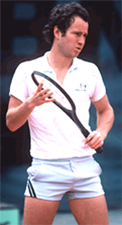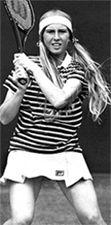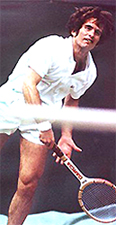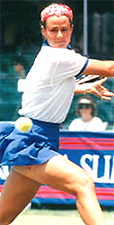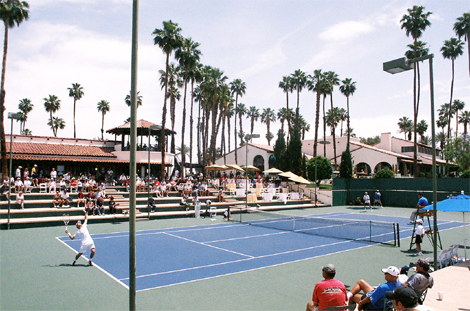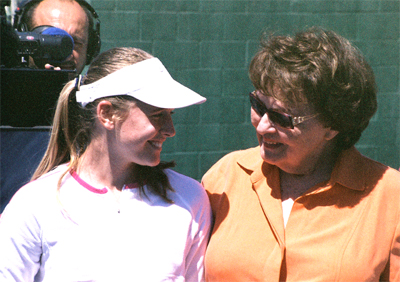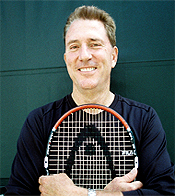
Easter Bowl 2007John Yandell
What's it's like to observe a few hundred of the best American junior players battling it out from close range? Intense, very intense. And inspirational. And also, illuminating when it comes to technical and tactical styles. The Easter Bowl in Palm Springs has been a premier showcase for American junior tennis for decades. It's the 40th event, founded by New York marketing and event executive Seena Hamilton, when her son was in the juniors. It's the only event of its kind because the Easter Bowl has the boys and girls in the 14s, 16s and 18s, all at the same place at the same time. Entries have always been limited to American juniors, and now it is a USTA national championship, as well an ITF championship in the 18s. It's a huge event, with over 600 kids, plus their families and coaches. In the early years, the Easter Bowl was played in Manhattan with about 100 kids in all 6 divisions, including a stint at courts in a bubble under the 59th street bridge. In subsequent years as the event grew, it's been across the country and back: Florida, Arizona, back to Florida, and then the Palm Springs area, at the Riviera Country Club.
This year, with the Riviera closed for renovations, Seena moved it again, down Highway 111 a few miles to Rancho Mirage and a gorgeous old style resort thre called Las Palmas. (Click Here.) I thought the tennis director's name looked familiar when I walked in, and sure enough, it turns out Kevin Connolly is a Tennisplayer subscriber. Future Stars I'd never been to the Easter Bowl and it seemed like the perfect opportunity to film for a new section on Tennisplayer we are starting this month, called Future Stars. The idea is to film stroke clips of top juniors and put them up for the kids to see, as well as the coaches and the parents. It's a new free part of Tennisplayer. (Click Here to check it out.) Besides satisfying my own curiosity, I wanted to see if this footage might add to the discussion about the state of American junior tennis and a closely related topic, the evolution of technique. What did our top kids really look like and what style or styles did they play?
So Associate Editor Matt Gould and I packed up the video cameras and headed on down to the desert, planning to stay 3 days at most. But that's not how it worked out. Matt had to get back, so I put him on a plane, but I ended up staying for the entire event and watching the finals in all six divisions. I just got drawn into the whole experience. There was great tennis energy, and yes, some over-competitive emotional toxicity, but much less than I expected. And OK, I admit it, it's still raining in San Francisco and I love that warm dessert weather, and after the Osmosis Clinic (Cick Here) and Indian Wells, it was a real treat to get there back again. But after I saw so many great kids play one or two matches, I couldn't resist staying to see how it was all going to shake out. On my second day I ran into top Florida junior coach and Tennisplayer contributor Nick Saviano (Click Here), himself a former Easter Bowl champ. I asked him what made the event so special. His answer: "It combines the boys and girls and all the age divisions, and this creates a wonderful, synergistic environment not just for the players, but for the parents and the coaches." When you look back at the list of past champions it's pretty incredible. Harold Solomon and Dick Stockton in the first year of the event. Gene Mayer, Tracy Austin, Pam Shriver, John McEnroe, Andrea Jaeger, Jennifer Capriati, Zina Garrison, Jeff Tarango, Andy Roddick, and a couple of of recent American pro prospects, Sam Querry, and Donald Young. (So counting Gene Mayer, Coach Saviano and Johnny Mac, that makes 3 former champions who are all Tennisplayer contributors--I had no idea.) But if you take a look at the list of past champions, there are many more names you never heard of. Remember Jack Gorsuch, David Siegler, Jarrett Chirico, David Kass, Ditta Huber or Lindsay Burdette? All Easter Bowl Champs.
It's not that they weren't elite junior players. A lot of people look around at the Easter Bowl to see who might be the next superstar, but that's more or less impossible to predict. If you look back at the results over the 30 years of the event, there are only a small number of big name players who actually won the event. Of the 200 plus Easter Bowl champions, only around 20 players ever made the top 50 in the world. Only 4 ever won a major singles title. Andre Agassi, Pete Sampras and Lindsay Davenport never got past the semis. Michael Chang got to the finals, as did Jimmy Connors. Players we don't remember beat these legendary champions every year at the Easter Bowl. So what does that really predict? Making that point to the players and parents is actually one of the things the Easter Bowl is about. According to Seena Hamilton, "When professional tennis was exploding in the 1970s, I realized parents were beginning to get very focused on the idea that "my kid can be champion." I decided it was time to do a seminar for parents warning them not to abandon a sensible education quite so quickly." That seminar became an annual Easter Bowl event and expanded to seminars all over the country. To play the event with a healthy attitude, you have to believe that playing tennis at this level is its own justification and reward--and yeah, it might help you get into and even pay for college.
Stunned and Amazed So what were the matches like? I was stunned and amazed at the incredible quality of the tennis. These kids hit the ball unbelievably hard. And they hit it unbelievably well. Those two things don't always go together. What I saw was incredibly powerful ball striking, but the players were also very consistent, well-rounded, and far more tactically sophisticated than I would have guessed. One of the big topics in coaching for the last 10 years has been the forehand grips of young players. Have the grips become so westernized that they create limitations in later development? I've seen that issue myself, coaching high school tennis and watching kids I've worked with in sectional tournaments. It's depressing because you see kids hitting way more spin than their game requires, hitting lots of short, ugly moonballs, having relatively little variety, and either pushing their way through matches or blasting one ball in and then one ball out. But at the Easter Bowl, I didn't see one match in the main draw that was decided by moonball exchanges, or one player that you could characterize as a hardcore pusher.
This was the knock on western grips when they started to dominate the juniors. But it seems to me that the junior game has evolved, in a way not dissimilar to what has happened with the grips in the pros. In general the kids were all going for it, taking full swings and not holding back. But they also seemed to be trying for winners at the right times, and using their ground strokes to set up opportunities, not just mindlessly blasting away. So what were the common technical elements? In general, moderate semi-western and extreme semi-western grips were universal. The players seemed to all be somewhere between Agassi and Roddick, but very few if any as far underneath as Nadal. I can't say I saw many or even one player with Federer's grip. But then again very few players on the tour have that grip either. Probably the more extreme semi-westerns were the most common, what we've called the "4 / 3.5" and the "4 / 4." This means the palm of the hand is partially behind the handle and also partially underneath the handle. These are similar to the tour grips used by players like Roddick, Fernando Gonzales and David Nalbandian. (Click Here for a detail discussion of all this.) In general the boys were somewhat more extreme and the girl's somewhat less so, but there were exceptions of both sides. So if the kids weren't hitting moon balls, why the more extreme grips? The answer is something we looked at last month in the Osmosis forehand article. (Click Here.) Contact height. And this is directly related to spin.
The kids are hitting the ball so hard with so much spin that the ball is just screaming up off the court. The ball bounce can be shoulder height or even higher. It's actually very similar to the pro game, except the kids are shorter and not hitting the ball (quite) as hard. But the result is similar. Very few balls are at waist level. Instead the top of the bounce is mid-chest to shoulder height and above. Yes Roger Federer steps in and takes many of these balls on the rise, at waist height or somewhat higher, which is the comfort zone for his modified Eastern grip . Agassi did the same thing with is mild semi-western. But that's almost superhuman. It's so difficult to time the ball, only a tiny number of players can compete successfully with that kind of strike zone. For the average elite junior player, the answer is different. The answer is to slide under the grip, let the ball come up off the court and develop a higher natural strike zone. The answer to speed and heavy spin in the juniors is similar to the answer on the tour: speed and heavy spin.
It's a chicken and egg deal. Once the first player goes underneath and starts hitting screaming high bouncing topspin drives, the other player either has to step in, move way, way back, or adopt the same tactic. And that's what the players do. They let the ball bounce up to the top of the bounce and learn to hit hard with a lot of spin. This seems to be the universal direction of American junior tennis, at least if my observations at one big national event is any indication. For this reason most of the points in most of the matches were power baseline exchanges. In dealing with the high bounces, it's true many of the kids play 6 or even 12 feet off the baseline--at least at times. But what I saw was that most of the players were trying move up and play tighter whenever they could, and push their opponent's back and open the court side to side. If they could get ahead doing this, they wanted to move into the court and try to finish on shorter balls. When it came to the backhands, the two-handers dominated as you might expect, although Johnny Hamui got to the boy's 18s final with a really fluid and effective one-hander. (More on that below.) Beyond that I saw 3 other players hitting one-handers, including one in the girls. There were probably a few more than that, but you get the idea. I asked Nick Saviano about it, and he as usual, had an interesting take. He thinks that the one-hander can be as effective or even more effective, but only for the players with greater athleticism. Otherwise it becomes a liability, at least in terms of competitive results, and this explains why the two-hander is near universal.
The Net? So the junior game is based on somewhat more extreme grips, heavy topspin, and two-handed backhands. But surprisingly, I saw that there was something else. I was surprised to see how many players were willing and even eager to go in. Yes, to the net. A good percentage of the players seemed very comfortable there. Not that many were looking to get up as a regular strategy in every game, although there were exceptions to this, including some of the players who ended up winning in various divisions. (More on this below.) But almost all of the players were taking the obvious opportunities to go in. And many or even most of the players I saw go in seemed comfortable, even natural there, and were able to execute effective classic and/or swinging volleys. A few also had killer overheads. And what about the serves? The one thing that did surprise me was the level of technical mastery across a wide number of players. It seemed in general lower than the groundstrokes, or even the volleys. Plenty of the boys were serving 110mph or even 120mph in the 16s and 18s. Some of the girls were serving quite hard as well. But there weren't many motions you'd call gorgeous or even fluid. What I saw was a lot of abbreviated windups that just didn't seem to flow. I also saw contact points that were all over the place--too far right, too far left, and too far back. These problems were significantly worse for the girls. That was interesting because it seemed technique on the serve was lagging way behind the level of the rest of the American game. Spirit of the Easter Bowl So that's the overview, technically. And like I said, it was very intense out there on the court. I know because I was standing right there at the net filming all week. In general though it appeared to me that almost all of the players were competing with a lot of healthy spirit. Maybe I just caught the Easter Bowl in a calm year. But, having seen so much bad behavior at the sectional level, I was surprised that there appeared to be so little cheating, gamesmanship, and psycho-hysteria at this huge, famous national event. And the parents in general seemed better too--less crazed, less self-important, less over-involved. Although flashes of all that were certainly on display through most of the week.
Or maybe it's the staff of the Easter Bowl. In large part they have been with Seena for years. From day one they set a tone that sort of dominated the event. The few times you could hear kids getting loud, one of tournament people was on it. The funny thing was the tone wasn't that high and mighty attitude players come to despise in so many amateur officials. We've all seen examples of tournament referees and umpires who glory in power. The Easter Bowl deal was different. I was listening to one kid questioning calls and berating himself and his opponent at a volume that was audible about 5 courts away. Suddenly you hear a loud adult voice shout; "Pipe down now!" The interesting thing was it was at virtually the same intensity level as the kid. I thought it must be a deranged opposing parent, but I looked over and to my surprise it was one of the roving officials. Now that was interesting. The best part was what happened next, because the kid started back tracking like crazy, "Yes sir, I'm sorry sir. You're right. It won't happen again." And this was in a completely different, suddenly respectful voice. It made me laugh. And from that point forward the kid was pretty much silent. I saw a couple more similar incidents--enough to see that the tournament had a personality. It wasn't about humiliating and making the kids wrong. It was just about letting them know what the rules were. The tournament people all seemed to know they were doing something great for the kids. And the kids were just going to have to behave--period. It was an unconventional, benevolent kind of authority that was refreshing, even inspirational for someone seeing the event for the first time. I think that all starts with Seena. One thing you saw time and time again was her sincere interest in the kids and in their families. She and I sat down for an interview and talked for about an hour and I was amazed at how outspoken she was on so many controversial topics in tennis, how right she seemed on quite a few issues most people won't even talk about, and how seemingly fearless she was of the political sequences of many of the things she said. More on that possibly in the future articles.
The other interesting component is that the event get daily coverage in the local paper, the Desert Sun, and of special interest to the kids, blow by blow reporting on JuniorTennis.com, which covers the event on a daily basis. If you haven't found this site, it's a great window into the world of high level junior tennis. (Click Here.) Everyday during the Easter Bowl, JuniorTennis posts detailed stories about the matches and includes interviews with the kids, which sometimes have hilarious quotes about their antics on and off the court. There is also a very comprehensive photo gallery, so you can see both the competitive records of the kids, and photos. Seena feels this is another benefit of the tournament, because the kids often get their first real experience dealing with the media. I was sitting in the press room during some of the interviews and it was obvious the players found it all really exciting and that it was a big deal to be able read about themselves and their fellow competitors in the media the next day. Finally, in the last couple of days of the tournament, she films a television special that documents the event, which shows on local TV in the dessert. Again you've got TV cameras on the court, one more thing that it makes it seem like the big time for the players.
Contact Tennisplayer directly: jyandell@tennisplayer.net Copyright Tennisplayer 2005. All Rights Reserved. | |||||||||||||||||||||||||||||

